Recent Posts
Navigating Storm Hazards: Florida's Spring and Summer Weather Challenges
4/29/2024 (Permalink)
As the Sunshine State gears up for spring and summer, Floridians know all too well the unique challenges that come with the changing seasons. While the warm weather and outdoor activities beckon, SERVPRO® of Central Brevard wants to remind you that it’s crucial to be aware of the storm hazards that accompany this time of year. From thunderstorms to hurricanes, Florida's weather can be unpredictable and sometimes dangerous. Here’s what you need to know to stay safe and prepared:
1. Thunderstorms: Florida experiences frequent thunderstorms during the spring and summer months. These storms can bring intense lightning, heavy rainfall, and strong winds. With the potential for lightning strikes and localized flooding, it’s essential to have a plan in place and to seek shelter indoors when thunderstorms approach.
2. Hurricanes: Florida is no stranger to hurricanes, and these powerful tropical storms can wreak havoc when they make landfall. Spring and summer mark the beginning of hurricane season in Florida, which runs from June 1st to November 30th. It’s crucial for residents to have a hurricane preparedness plan, including stocking up on supplies, securing property, and knowing evacuation routes.
3. Flooding: Florida’s low-lying terrain and extensive coastline make it particularly susceptible to flooding, especially during heavy rainfall or storm surges. Even a brief period of intense rain can lead to flash flooding in certain areas. Homeowners should take proactive measures to protect their property, such as installing flood barriers and ensuring proper drainage around their homes.
4. High Temperatures: With its subtropical climate, Florida experiences hot and humid summers. Heatwaves can be especially dangerous for vulnerable populations, such as the elderly and young children. It’s important to stay hydrated, seek shade or air conditioning when possible, and avoid strenuous outdoor activities during the hottest parts of the day.
5. Tornadoes: While not as common as in the Midwest, tornadoes can and do occur in Florida, particularly during severe thunderstorms or hurricanes. Residents should be familiar with tornado safety procedures, including seeking shelter in a sturdy building or interior room away from windows.
In conclusion, spring and summer in Florida bring a mix of sunshine and storm hazards. By staying informed, having a plan in place, and taking proactive measures to protect yourself and your property, you can weather the storms safely. Remember, preparation is key when it comes to navigating Florida’s ever-changing weather patterns. Stay safe, stay informed, and be ready for whatever Mother Nature brings your way.
Spring Water Damage Prevention Tips for Florida Properties
3/20/2024 (Permalink)
As spring arrives in Florida, it brings the potential for water damage to homes and businesses. With increased rainfall and storms, it's crucial to take proactive steps to protect your property. Here are some quick tips:
1. Roof Check: Inspect your roof for damage or missing shingles. Prompt repairs can prevent water from seeping in during heavy rains.
2. Gutters and Downspouts: Keep gutters and downspouts clear of debris to ensure proper drainage and prevent water damage to walls and foundations.
3. Monitor Humidity: Florida's warm climate can lead to indoor humidity, promoting mold growth. Use dehumidifiers and keep indoor humidity levels below 60%.
4. Plumbing Inspection: Check for leaks in faucets, toilets, and under sinks. Repair any leaks promptly to prevent water damage and mold growth.
5. Landscaping Maintenance: Trim trees and shrubs to prevent branches from falling on the roof during storms. Ensure proper grading to prevent water pooling near the foundation.
Stay proactive and implement these measures to minimize the risk of spring water damage. Remember, SERVPRO is here to help if water damage occurs. Our experts are available 24/7 to mitigate damage and restore your property. Let us be your partner in water damage prevention and restoration this spring!
Restoring Fire Damage in Florida: Making It "Like It Never Even Happened" with SERVPRO
3/20/2024 (Permalink)
When fire strikes a home or business in Florida, the aftermath can be devastating. Not only does fire damage compromise the structural integrity of the property, but smoke and soot residues can also permeate surfaces, leaving behind lingering odors and discoloration. At SERVPRO, we understand the urgency and complexity of fire damage restoration, and we're here to help make it "Like it never even happened."
Our fire damage restoration process begins with a swift response to assess the extent of the damage and secure the property to prevent further harm. Our expert technicians utilize advanced equipment and techniques to remove debris, clean soot residues, and eliminate smoke odors from affected surfaces. We meticulously restore salvageable items and surfaces, striving to return the property to its pre-fire condition as efficiently as possible.
In addition to addressing visible damage, we also prioritize air quality and safety. Our comprehensive approach includes air purification and deodorization to ensure that the indoor environment is clean and healthy for occupants. We work closely with property owners and insurance companies throughout the restoration process to streamline communication and minimize disruptions.
At SERVPRO, we're dedicated to delivering exceptional results and restoring peace of mind to our customers. With our proven expertise and commitment to excellence, we make fire damage restoration in Florida "Like it never even happened." If your home or business has been affected by fire, don't hesitate to contact SERVPRO for prompt and professional restoration services.
Let us be your trusted partner in fire damage restoration, and together, we'll overcome the challenges and restore your property to its former glory. Contact SERVPRO today to learn more about our fire damage restoration services in Florida.
SERVPRO Offers Ways to Effectively Remediate Mold Damage in Your Home
4/28/2023 (Permalink)
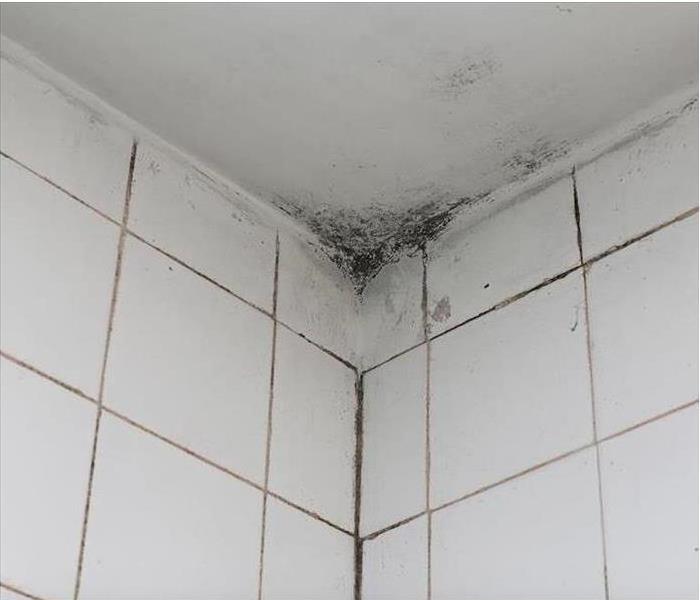 Regardless of the color of the mold in the corner of your home, contact team SERVPRO right away for remediation services.
Regardless of the color of the mold in the corner of your home, contact team SERVPRO right away for remediation services.
Mold Damage Remediation Options That Property Owners Should Consider
How well is your family prepared to deal with mold damage? We all know that disasters do not plan, but we can make emergency plans today to protect us from possible health effects and reduce unnecessary damage when such incidents come knocking. The recent devastating wildfires and hurricanes reminded our country of the benefits of preparing to face disasters. We hope all residents of Central Brevard, can find useful information in this article to up their preparedness skills.
After addressing the safety concerns of the building, our SERVPRO of Central Brevard, technicians perform a site-assessment to come up with an effective and safe work plan during mold damage remediation in your area. During this step, we determine the degree of the mold and moisture problem. We watch out of discolored surfaces, fuzzy growth on furnishing and items, and musty odor. Mold tends to grow in hidden areas, so, we check behind the wallpaper, insulation, wallboard, as well as carpet backing and padding.
Exposure to the mold spores can cause health effects, and it is essential to use the appropriate personal protective equipment. To protect our feet, we use work boots that are waterproof. Safety glasses with a full-face shield, waterproof gloves, disposable earplugs, and disposable coveralls are some of the PPE that we use. Where necessary, we decontaminated some of the contaminated PPE at the end of the remediation process.
We can also assess the contaminated items and determine what is salvageable and what is not. We discard porous contents such as papers, rugs, carpeting and padding, upholstery and textiles that have significant mold contamination. Removal and disposal of contaminated porous building components such as insulation, ceilings, plaster walls, floor sills, and non-structural wood studs may be necessary.
After cleaning surfaces and restorable items, we apply disinfectants to lower chances of mold problem reoccurring. We have also to dry the structure to address the existing mold growth conditions. We can set up space heaters and perform dehumidification to speed up the drying process.
At SERVPRO of Central Brevard, We are Faster To Any Size Disaster, and we can handle your restoration or cleaning needs. Contact our team at (321) 638-4947 to benefit from our trusted restoration services.
What Are the Most Common Types of Storm Damage?
3/27/2023 (Permalink)
Storm damage can occur in a variety of ways including flooding, wind damage, and even fire. Flooding rains can extensive amounts of damage to your home, lightning strikes can cause fires, and high winds can cause a number of structural issues .
But which is the greatest risk to your home and homes around the country?
The risk for each of these depends on the areas in which you live. If you live in low-lying areas or coastal areas prone to tropical systems, flood damage is going to be the mostly likely cause for concern. Inland areas, particularly in Texas and across the mid-west are most susceptible to wind damage from tornadoes. Fire damage from lightning strikes can occur anywhere at any time.
The Most Common Type of Storm Damage
Annually, flooding is the most common and extensive form of storm damage that occurs in the United States. Even during high wind events like tropical storms or hurricanes, the majority of the damage comes from the flooding rains from the storms and not the destructive winds.
Every year, insurance companies pay out more than a billion dollars to repair flood damage in the U.S.–and that number is only rising as property values increase and the number of homes in high risk coastal areas rise.
The amount spent on flood damage could continue to rise significantly in the future–especially if sea levels rise as predicted. If sea level rise occurs, thousands of homes in the United States will be at risk and potentially hundreds of billions of dollars will have to be spent to mitigate that damage.
Damage from flooding rains can penetrate every part of your home of business structure, requiring the gutting and replacement of much of the structural components inside, including walls, floors, ceilings, and more.
Call our professionals at SERVPRO of Central Brevard, when disaster strikes. (321) 638-4947
Merritt Island's Fire Damage Experts Describe Cleaning Appliances
3/20/2023 (Permalink)
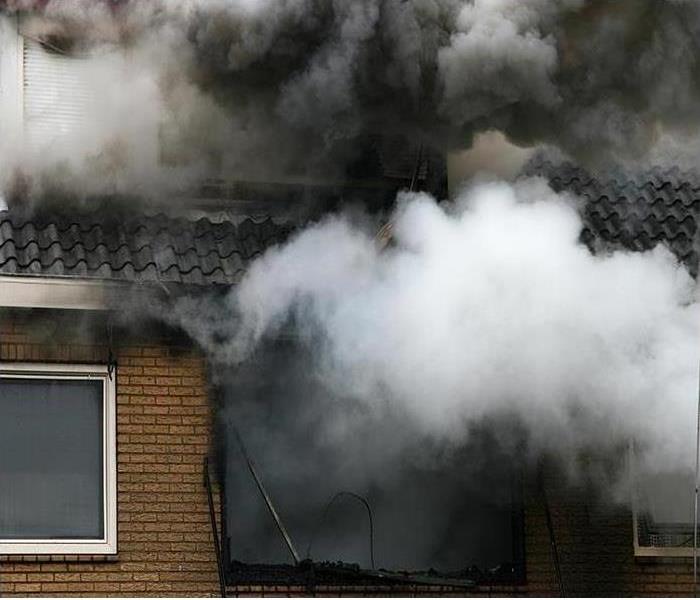 If a fire burns at your Merritt Island residence, structural components and building materials can suffer extensive damage.
If a fire burns at your Merritt Island residence, structural components and building materials can suffer extensive damage.
Fire Damage Experts Describe Cleaning Appliances
If a fire burns at your Merritt Island residence, structural components and building materials can suffer extensive damage. Depending on the size of the blaze, parts of the structure might have to be removed and rebuilt. Aside from the heat and flames engulfing and charring parts of the house, smoke created by partially combusted particles can cause problems in areas far from the source.
Smoke put out by burning materials travels all over your home creating pungent aromas and leaving behind soot residues. During some fire damage restorations in Merritt Island, soils coat several indoor surfaces including contents. To prevent damage to items and to aid in deodorization all soot residue gets removed from affected contents and materials.
Different things inside the house require various methods and chemicals to clean soot damage. How difficult soots come off surfaces changes based on what burned in the fire and the type of surfaces affected. Non-porous surfaces are typically the simplest to clean because wet chemicals can be used to wipe off the soot.
When smoke spreads throughout your house, appliances often get coated with soils. Appliances usually contain surfaces made from metal, paint, plastic, and glass. These surfaces can be cleaned using a water-based detergent solution. If the soot is challenging to remove with the cleaning agent, then our SERVPRO technicians use another chemical to increase the alkalinity of the detergent.
Many appliances have highly polished finishes that can get damaged by cleaning agents. Chrome or aluminum can pit if industrial detergents are left on the surface. After using soaps to remove soot residues, applying a rinse chemical can prevent damage caused by the cleaning process.
In some cases, heat from a fire can cause finishes on appliances to turn yellow. When yellowing occurs, wood creme paste gets applied to the affected surface with a towel. We then allow the creme to set on the surface for two to three minutes. After it sets, we use steel wool to gently scrub the yellowish staining off. Once we agitate the surface with the paste, it gets polished with a clean towel.
Using the correct methods to remove soils can reduce the overall cost of the restoration project. For help from the professionals with any mitigation project, call SERVPRO of Central Brevard, at (321) 638-4947 seven days a week.
Click here for more about Merritt Island.
Why should I not take care of water damage myself?
3/8/2023 (Permalink)
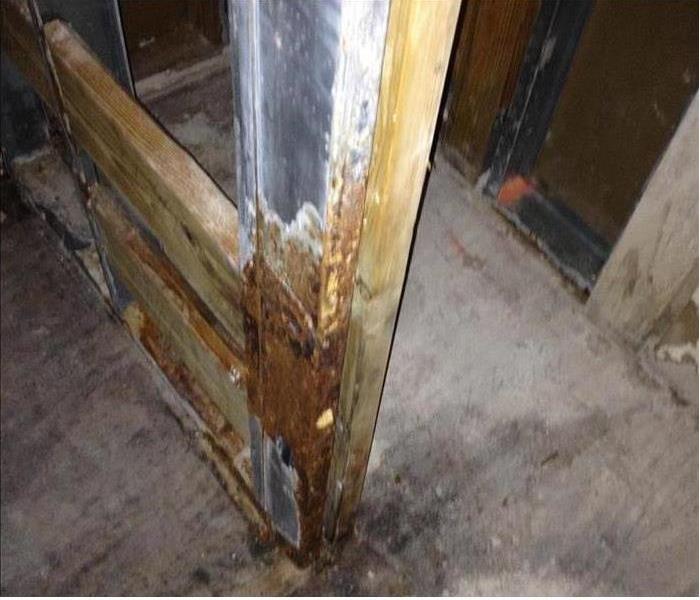 Water damage left too long and it resulted in have to remove all the dry way down to the bare studs-- you can even see rust on the stud!!
Water damage left too long and it resulted in have to remove all the dry way down to the bare studs-- you can even see rust on the stud!!
Even a small amount of water can cause a lot of damage to a property and if corrective action isn’t taken right away, the homeowner may bear the cost of the clean-up. This is because most homeowner insurance policies will state that it is the homeowner’s responsibility to try to limit further damage to their home after a water loss. If they don’t do anything, the insurance company could deny the claim.
On top of this, the longer there is water in a home, the greater the possibility of the home experiencing secondary damage. This is when materials that are wet sustain additional damage that then becomes more expensive to fix. A good example is when wet drywall is not properly dried and then becomes moldy. Another one is when you have a wet room that is not addressed and the high humidity levels cause damage to another room that wasn’t originally affected.
Secondary damage is always more expensive to mitigate than the original water damage but can be avoided is corrective action is taken right away!
At SERVPRO of Central Brevard, we have successfully mitigated water damages in hundreds of homes in our over 19 years of service to the Space Coast!!
Once you see our green trucks pull into your driveway or parking lot, you can rest assured you’re in capable hands. We have the latest modern, commercial-grade drying equipment available, including, extractors, dehumidifiers, air movers, hardwood floor drying systems, and each of our trained technicians are certified and water restoration.
Drying Structural Areas of Your Cocoa Home after Water Damage
7/26/2022 (Permalink)
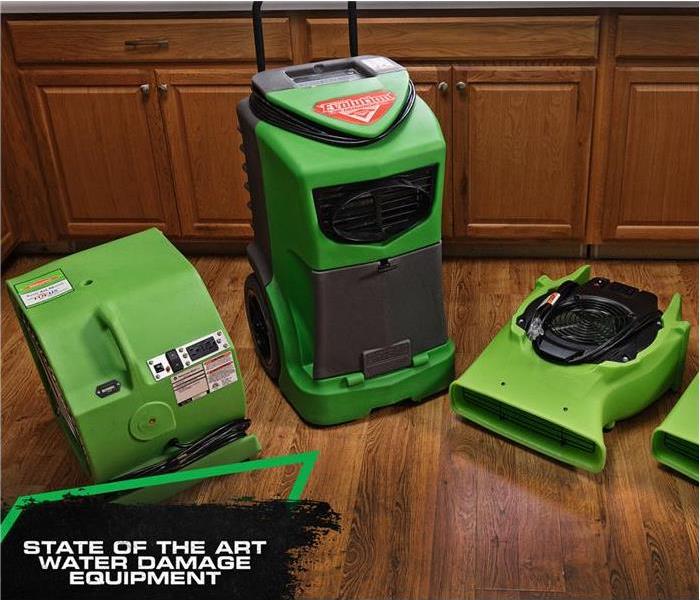 SERVPRO provides advanced equipment for water damage mitigation in Cocoa. "Like it never even happened."
SERVPRO provides advanced equipment for water damage mitigation in Cocoa. "Like it never even happened."
SERVPRO Follows Protocols to Facilitate Water Mitigation in Cocoa
Water becomes a menace when it spreads to unintended areas of a Cocoa property. Structural materials such as frames, studs, walls, and ceiling panels are particularly vulnerable to moisture exposure. Luckily, drying procedures can help prevent or reverse severe water damage. Drying structural areas to combat water damage requires combining several strategies, including demolition, manipulating airflow, and dehumidification.
When an incident at your Cocoa home leaves water damage, the impact can be selective, affecting contents such as furniture, or it can be restricted to structural areas such as walls, floors, or ceilings. The source of the leak plays a significant role in determining what is affected. Unlike contents that you can easily move to facilitate drying, wet structural materials are rigidly attached to the building. SERVPRO provides the expertise and technological resources that ease water restoration.
Removing moisture from structural materials occurs in different states, including liquid and vapor. Moisture has to move from the core of the material towards the surface, where it can escape into the air through evaporation. Although evaporation happens naturally, the standard rate is too slow, especially in concealed areas, so it is essential to find a way to fast-track it.
Ways to boost evaporation
- Improving airflow
- Humidity control
- Temperature control
If the air circulating over wet surfaces is constantly moving, it acts as a sweep moving the moisture escaping from the wet materials away, thus speeding up the drying process. Our SERVPRO crews set up several air movers to create a constant air stream over a damp surface. The air moving around the wet materials should have minimal humidity levels for sustained evaporation and faster drying. If deemed necessary, our technicians include dehumidifiers within the set-up of drying equipment. Temperature control complements the drying efforts by improving the capacity of air to hold moisture.
Reaching Wet Structural Materials
Structural materials such as drywall, floorboards, and ceiling panels are readily accessible, making it easy to execute the drying processes. However, the elements hidden within ceiling spaces, subfloors, and wall spaces are not readily accessible, so extra steps are necessary to facilitate drying. Our SERVPRO IICRC-certified technicians can punch vent holes or make flood cuts to create the required access to circulate dry air close to the wet materials. Vent holes are small openings, usually less than an inch in diameter, drilled through a wall to create access for circulating air inside the wall. Our technicians hook special wall ventilators through the holes to facilitate positive or negative air pressure into the cavity. We can rig various InjectiDry devices to optimize the drying time and result.
In some cases, materials may be readily accessible but have vapor barriers that impede drying. A vapor barrier is a material that does not let moisture through, or if it does, the rate is very slow. For example, wall surfaces coated in gloss paint or wallpaper. Defeating the vapor barrier is essential before drying can be successful. Our SERVPRO technicians use different workarounds against the moisture barriers, including modifying or removing the material. We can use a perforation roller to create tiny holes allowing faster moisture release. Stripping the surface, especially if the barrier is wallpaper is also helpful.
Other common vapor barriers:
- Felt paper under hardwood floors
- 4-mil polyethylene sheet under drywall
- Semi-gloss paint
SERVPRO of Central Brevard uses professional approaches to handle water damage making it "Like it never even happened." Call us at (321) 638-4947.
What It Takes to Restore a Cocoa Home after Fire Damage
7/26/2022 (Permalink)
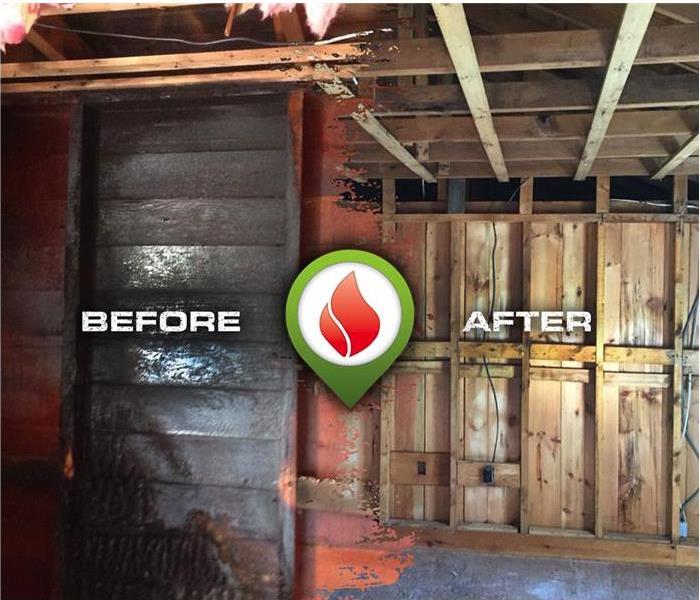 Fire damage cleanup and controlled demolition are cornerstones of SERVPRO. We make your Cocoa home look "Like it never even happened."
Fire damage cleanup and controlled demolition are cornerstones of SERVPRO. We make your Cocoa home look "Like it never even happened."
SERVPRO Provides Comprehensive Resources to Cocoa Homeowners after Fire Loss
Fire is a combination of different elements. Apart from the heat, it produces various chemical agents that spread across properties as fine particles, aerosols, and gases. These byproducts have distinct effects on materials, so restoring fire damage takes several approaches, including applying different cleaning products and procedures. Without sufficient resources, restoring your Cocoa home to its preloss state can be a mirage.
In your Cocoa home, fire damage occurs in stages. The most significant damage occurs when materials are engulfed in flames. This stage can consume many elements, reducing them to ashes. The gases, aerosols, and fine particles floating around the home during combustion, soil, stain, and leave a strong odor in fabrics, wood, and other materials. Finally, when residues like soot settle on surfaces, they can degrade them through corrosion and staining. Polished metal and stone surfaces such as backsplashes or countertops are susceptible to such damage.
Fixing fire issues requires the right:
- Knowledge
- Equipment
- Workforce
- Chemical agents
You can categorize knowledge about fires. Knowing what is affected, what can be salvaged, and what should be immediately disposed of are some of the top categories of information. Whether something is salvageable depends on factors like the level of damage, restoration cost, and the ease of replacement. SERVPRO has extensive industry experience, making it easier to categorize items as salvageable or unsalvageable. Whether canned or refrigerated, foodstuffs fall in the unsalvageable category since they are readily replaceable and become toxic from heat or chemical exposure.
Resources that Help Resolve Fire Damage
Appropriate resources are essential whether you need to clean, strip, or refinish a burnt area. These could be products or equipment to facilitate specific processes. Extra pair of hands is also helpful in facilitating simple or complex tasks. SERVPRO combines all these factors by sending a well-staffed and equipped team to your fire damaged property.
Necessary restoration equipment
- Abrasive cleaners
- Deodorization equipment
- Deep cleaners
- Drying equipment
Fire and smoke residues adhere strongly to surfaces due to bonding with the surface or deterioration of the underlying material. For example, areas with wet smoke residues are deeply soiled. Breaking the bonds requires sufficient force that only abrasive cleaning equipment can deliver. Pressure washers and rotating brushes are standard tools when a strong physical force is needed. For deep cleaning, immersion in cleaning solutions may be necessary. Ultrasonic cleaners help when cleaning small items.
In some cases, chemical breakdown of soils is better than using physical force, especially when it might damage the affected materials from poor handling. Our SERVPRO crews use specially formulated products to facilitate such cleaning. Heavy-duty cleaning detergents that are highly alkaline and contain ammonia are essential for this task. They are reliable in removing greasy fire residues and other difficult soils.
One should not forget secondary or invisible problems after dealing with the soiling and material deterioration left in a property by fire. Moisture issues and odors fall in this category since it is easy to overlook them until they interfere with your daily routines. Our SERVPRO technicians set up dehumidifiers or air movers to manage moisture, whether from cleaning processes or firefighting efforts. An air mover evacuates wet air from the house. A dehumidifier removes the humidity accumulating in the air. In both cases, the evaporation rate from wet materials increases, thus boosting drying.
SERVPRO of Central Brevard addresses all aspects of fire damage, from deteriorated materials to strange odors. Call us at (321) 638-4947. We're Faster To Any Size Disaster.
Cocoa Residences Require Professional Mold Damage Remediation
7/26/2022 (Permalink)
 SERVPRO techs don Tyvek clothing and respirators when remediating mold damage in Cocoa homes and attics.
SERVPRO techs don Tyvek clothing and respirators when remediating mold damage in Cocoa homes and attics.
SERVPRO Uses EPA Approved Mold Remediation in Cocoa Homes
Effective mold damage interventions for Cocoa properties are essential when spores encounter water and microbial growth gets out of hand. The use of proven best practices helps preserve and restore structural components and contents affected by rapidly multiplying fungi. The Environmental Protection Agency (EPA) conducted extensive research that resulted in a comprehensive mold remediation protocol applicable to and successful in commercial and residential settings used by professionals specializing in microbial removal and control.
EPA-Guided Mold Clean Up Delivers Consistently Outstanding Results
Remediation strategies designed by the EPA comprise the undisputed industry standard, clarifying why SERVPRO crews responding to Cocoa mold damage confidently rely upon them. Resolving a fungal infestation includes ticking off the specific steps listed in the EPA process to find and safely rid a dwelling of active colonies of mold organisms. Mold damage results only when endemic spores encounter and absorb water, fueling growth on available organic surfaces such as a broad range of common building materials. Inhibiting resurgence is also vital to protect properties from continuous microbial damage and requires an overarching moisture management plan.
Why Is SERVPRO A Good Fit for Mold Damage Removal?
Expertise in water damage restoration and applied structural drying techniques offers Cocoa customers an advantage when choosing a mold remediation partner, which is why SERVPRO ranks highly among property owners struggling with persistently wet areas. Lingering water damage can fuel mold outbreaks if not remediated within 24 to 48 hours. Our Institute of Inspection, Cleaning and Restoration Certification (IICRC)-trained technicians are experts in finding the sources of water incursions and tracing moisture migration throughout a home’s building materials and fixtures. Techniques and tools employed include:
- Infrared imaging, which permits comparing temperature fluctuations to pinpoint wet or water-filled spaces behind surfaces
- Moisture detectors help establish the perimeters of water spread
- Moisture meters are critical to developing drying goals and monitoring progress by periodic moisture level measurement of wet components contrasted with baseline data from unaffected yet similar building materials
- Thermo-hydrometers, are capable of recording both temperature, and relative humidity levels as some spores begin multiplying when humidity levels exceed 60 percent
What Are the Other Steps in the EPA Mold Remediation Protocol?
Identifying and testing for the intensity of water damage and persistent moisture helps remediators locate the spaces within your Cocoa home that exhibit conditions supportive of microbial growth and damage. This is the crucial first step in fungal remediation, which is why SERVPRO uses its expertise and takes the time to scope for water and moisture damage. The subsequent phases in the EPA process include:
- Containing the affected structural components and workspace to prevent the spread, our technicians wrap the area with 1.6 mil polyethylene and use negative pressure air scrubbing technology to filter contaminants.
- Manually removing the moldy residues with scrapers, brushes, and other abrasive tools -- sometimes adding controlled blasting with media such as soda or dry ice to loosen organisms from porous materials and incapacitate the invasive hyphae that could otherwise encourage mold rebound.
- Clean up debris and residues with HEPA-filtered vacuums and wipe downs with EPA-registered cleaning products.
- Treatment of the affected materials and space with EPA-registered antimicrobials to inhibit the growth of spores in the area.
Water damage restoration and moisture management also must be part of the ongoing maintenance of your Cocoa home, which is why SERVPRO advises customers on how to limit water incursions and ensure optimum indoor humidity of 30 to 50 percent. We also offer services to address and resolve any underlying water issues.
Professional understanding of and capability to provide mold damage remediation best practices is why SERVPRO of Central Brevard is a regional restoration leader. Call (321) 360-4932 to conduct a mold damage assessment.

 24/7 Emergency Service
24/7 Emergency Service





